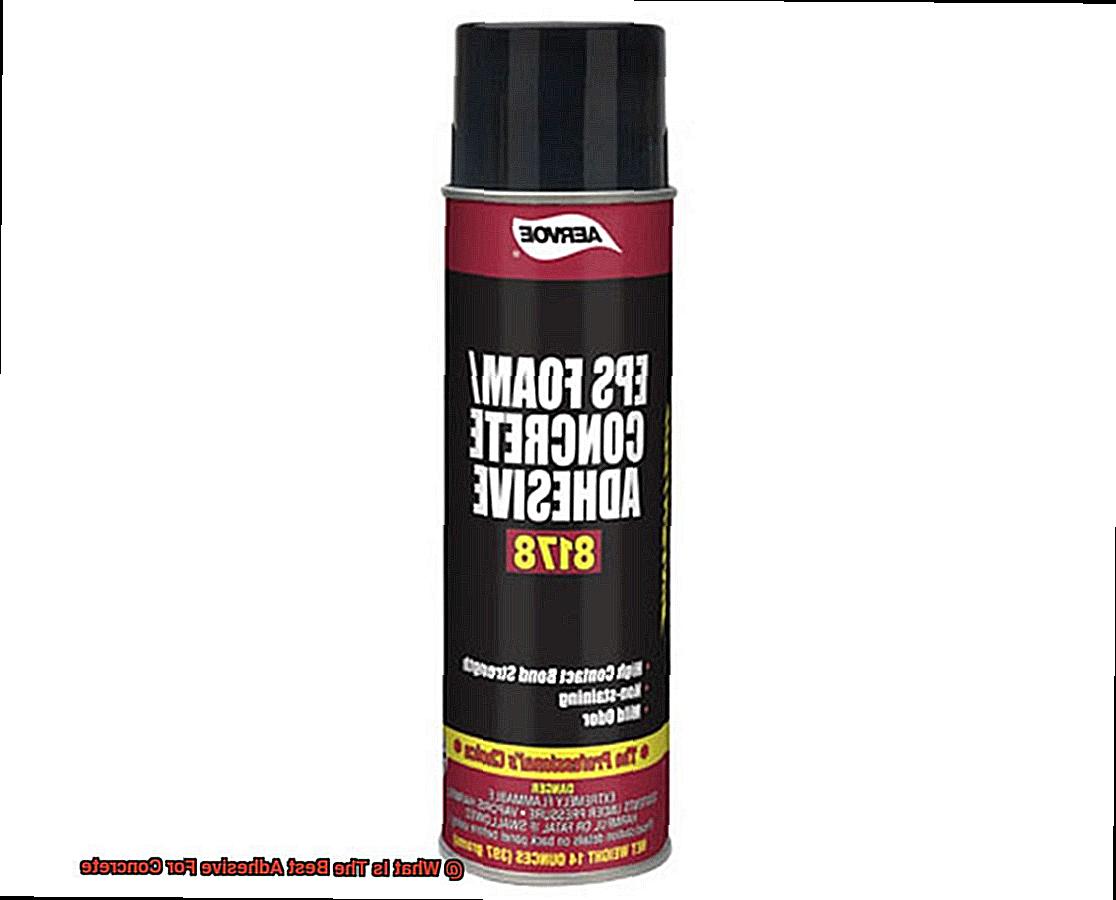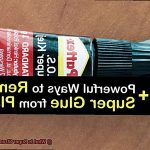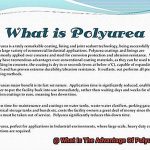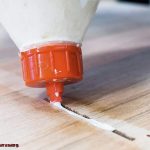When it comes to working on construction, renovation, or DIY projects involving concrete, finding the right adhesive is absolutely crucial. You want an adhesive that not only creates a strong bond but also stands the test of time. After all, who wants to deal with a crumbling mess down the line? But with so many options out there, how do you determine which one is truly the best?
In this comprehensive guide, we’re going to unveil the holy grail of concrete adhesives. This bad boy promises exceptional performance and peace of mind like no other. We’ll dive deep into its unique qualities, superior bonding capabilities, and all the amazing benefits it brings to the table.
Whether you’re tackling an indoor project or taking on Mother Nature’s wrath outdoors, this adhesive will be your trusty sidekick – providing unmatched strength and versatility every step of the way. Get ready to take your concrete projects to a whole new level of durability and endurance with our ultimate adhesive solution.
Let’s get started.
Types of Adhesives for Concrete
Contents
- 1 Types of Adhesives for Concrete
- 2 Factors to Consider When Choosing an Adhesive
- 3 Surface Preparation for Bonding Concrete
- 4 Application of Adhesive to Concrete
- 4.1 Step 1: Prepare the Surface
- 4.2 Step 2: Choose the Right Application Method
- 4.3 Step 3: Apply the Adhesive
- 4.4 Step 4: Consider Open Time
- 4.5 Step 5: Press Materials Firmly
- 4.6 Step 6: Account for Curing Time
- 4.7 Step 7: Consider Temperature and Humidity
- 4.8 Step 8: Reinforce if Necessary
- 4.9 Step 9: Practice Safety Precautions
- 5 Testing the Adhesive Before Use
- 6 Curing Time and Safety Precautions
- 7 Mechanical Fasteners and Adhesive Combination
- 8 Expert Advice on Selecting the Best Adhesive
- 9 Conclusion
When it comes to bonding concrete surfaces, there are several types of adhesives available in the market. Each adhesive has its own unique properties and applications. Let’s explore some of the commonly used adhesives for concrete:
Epoxy Adhesives
Epoxy adhesives are known for their exceptional bond strength and durability. These adhesives are perfect for heavy-duty applications, as they can withstand heavy loads and resist chemicals and moisture. Epoxy adhesives consist of two components – resin and hardener – that need to be mixed together before application.
Once mixed, they form a strong and reliable bond that can withstand extreme conditions. Whether you’re repairing cracks in a concrete structure or bonding concrete elements together, epoxy adhesives are a great choice.
Polyurethane Adhesives
If you’re looking for an adhesive that offers flexibility and resistance to temperature variations, polyurethane adhesives are a great option. These adhesives are suitable for both indoor and outdoor applications, making them versatile.
They have excellent adhesion to a wide range of materials, including concrete, wood, metal, and plastics. So whether you’re bonding concrete to wood or metal, polyurethane adhesives will get the job done.
Acrylic Adhesives
Acrylic adhesives are versatile and widely used for bonding concrete surfaces. They offer good bonding strength and resistance to weathering, making them suitable for both indoor and outdoor applications.
The best part is that acrylic adhesives come in ready-to-use formulations, so there’s no need for mixing. They also provide fast curing times, allowing for quick project completion. So if you’re working on a time-sensitive project, acrylic adhesives are the way to go.
Cementitious Adhesives
Cementitious adhesives are specifically designed for bonding concrete or masonry surfaces. These adhesives contain cement as a base ingredient, which makes them ideal for applications where the adhesive needs to blend seamlessly with the surrounding concrete surface. Cementitious adhesives are commonly used for tile installation or repairing cracks in concrete structures. So if you’re looking to bond tiles to a concrete floor or repair cracks in your driveway, cementitious adhesives are the perfect choice.
Cyanoacrylate Adhesives
Cyanoacrylate adhesives, also known as instant or super glues, are popular for their quick bonding properties. While they may not be the best choice for large-scale concrete bonding projects, they can be useful for small repairs or bonding lightweight materials to concrete surfaces.
Cyanoacrylate adhesives work by creating a strong bond through a chemical reaction with surface moisture. So if you need to fix a small crack in your concrete patio or bond a lightweight decoration to your concrete wall, cyanoacrylate adhesives will do the trick.
Factors to Consider When Choosing an Adhesive
Choosing the right adhesive for your concrete project is a crucial step in ensuring a strong and durable bond. But with so many options available, how do you make the right choice? Here are some important factors to consider:
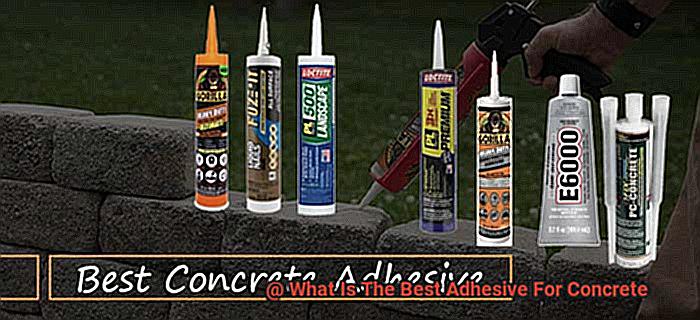
- Bond Strength: The adhesive should be able to handle the weight and stress placed on the concrete surface. Look for an adhesive with a high bond strength to ensure long-lasting results.
- Application Method: Different adhesives have different ways of being applied, such as spray, brush, or trowel. Choose an adhesive with an application method that suits your project requirements. A spray adhesive might be more efficient for large-scale projects.
- Setting Time: Consider your project timeline. Some adhesives take longer to set, while others offer quick-drying properties. Choose an adhesive that aligns with your schedule.
- Environmental Conditions: Temperature, humidity, and UV radiation can affect adhesive performance. Select an adhesive that can withstand the specific conditions of your project site.
- Chemical Compatibility: If your concrete surface will be exposed to chemicals or other substances, ensure the adhesive can withstand these exposures without degrading or weakening.
- Flexibility: Concrete surfaces may experience slight movements or vibrations over time. Choose an adhesive that offers flexibility to accommodate these movements without compromising the bond.
- Ease of Use: Consider the complexity of mixing ratios or the need for special equipment. Opt for an adhesive that is easy to work with if you’re doing a DIY project or have limited time and effort.
Surface Preparation for Bonding Concrete
Surface preparation is a critical step in ensuring a strong and long-lasting bond between concrete and adhesive. Without proper preparation, the adhesive may fail to adhere properly to the concrete surface, leading to weak bonds and potential failure of the attached materials. In this blog post, we will explore the importance of surface preparation for bonding concrete and discuss the key steps involved in preparing the concrete surface.
Thorough Cleaning:
Concrete surfaces are often contaminated with dirt, dust, oil, grease, or curing compounds, all of which can hinder adhesive adhesion. To remove these contaminants, thorough cleaning is required. This can be achieved using a power washer or a scrub brush along with a suitable cleaner or detergent. The goal is to eliminate all loose particles and contaminants that may be present on the surface. After cleaning, it is crucial to rinse the surface thoroughly and allow it to dry completely before proceeding to the next step.
Profiling for Better Adhesion:
Profiling enhances the mechanical bond between the adhesive and the concrete by creating a roughened texture on the surface. There are several methods available for profiling:
- Mechanical Abrasion: Tools such as grinders or shot blasters can be used to remove a thin layer of concrete and roughen the surface. This method is effective but time-consuming and requires specialized equipment.
- Acid Etching: By applying an acid solution to the concrete surface, a thin layer of cement paste can be removed, exposing a roughened texture. However, caution must be exercised when performing acid etching as it can be hazardous if not done properly.
- Chemical Surface Retardants: These retardants slow down the curing process of the top layer of concrete, making it easier to remove and exposing a roughened texture. They are applied to the surface and left for a specific period before being rinsed off.
Priming for Improved Adhesion:
After profiling, priming may be necessary to improve adhesion. Primers provide a bonding layer between the concrete and the adhesive. The choice of primer depends on the specific adhesive being used and the conditions of the concrete surface. It is essential to carefully follow the manufacturer’s instructions when selecting and applying the primer.
Application of Adhesive to Concrete
Bonding materials to concrete surfaces requires skillful application of adhesive for a strong and durable connection. Just as a painter needs a clean canvas, preparing the concrete surface is crucial for optimal adhesion. In this guide, we will explore the step-by-step process of applying adhesive to concrete, ensuring a masterpiece bond that stands the test of time.
Step 1: Prepare the Surface
- Thoroughly clean the concrete surface, removing dirt, dust, and debris that hinder bonding.
- Ensure a dry surface free from moisture, as even the smallest amount can compromise the bond.
Step 2: Choose the Right Application Method
- Select between brush-on, trowel-on, or spray-on methods based on adhesive type and project requirements.
- Follow manufacturer’s instructions for proper application technique.
Step 3: Apply the Adhesive
- Use the recommended amount of adhesive specified by the manufacturer.
- Ensure even and consistent application across the surface.
Step 4: Consider Open Time
- Open time refers to the workable period of the adhesive after application.
- Quick application is required for adhesives with shorter open times, while longer open times allow flexibility in positioning.
Step 5: Press Materials Firmly
- Firmly press materials onto the concrete surface for proper contact and maximum bond strength.
- Utilize tools like rollers or clamps to apply even pressure.
Step 6: Account for Curing Time
- Allow sufficient curing time for the bond to reach full strength based on adhesive type.
- Avoid excessive movement or stress on bonded materials during this period.
Step 7: Consider Temperature and Humidity
- Follow manufacturer’s guidelines regarding temperature and humidity requirements during adhesive application.
- Extreme conditions can weaken the bond.
Step 8: Reinforce if Necessary
Step 9: Practice Safety Precautions
- Wear appropriate personal protective equipment like gloves and goggles to prevent skin or eye irritation.
- Work in a well-ventilated area to minimize exposure to adhesive fumes.
Testing the Adhesive Before Use
When it comes to bonding materials to concrete surfaces, selecting the right adhesive is crucial for a successful project. However, not all adhesives are created equal. To ensure a strong and lasting bond, it is essential to test the adhesive before use. In this article, we will explore the importance of testing adhesives for concrete, the methods to conduct these tests, and the factors to consider during the process.
Importance of Testing:
- Selecting the right adhesive: Different adhesives have varying properties and strengths, making it crucial to find one suitable for concrete surfaces.
- Preventing potential issues: Testing helps identify problems such as poor adhesion, weak bond strength, or excessive drying time before they occur.
- Optimal performance and durability: Proper testing ensures that you choose an adhesive that will provide optimal performance and durability for your concrete application.
Methods of Testing:
- Peel test: Measure the force required to detach a sample of adhesive from a concrete surface at a specific angle, determining bond strength.
- Shear test: Evaluate an adhesive’s resistance to lateral or sliding forces by applying a load parallel to the joint surface.
- Environmental considerations: Test under various conditions (temperature, humidity, exposure to chemicals or UV radiation) to assess suitability for specific applications.
Factors to Consider:
- Adhesive compatibility: Select an adhesive specifically designed for concrete surfaces.
- Surface preparation: Ensure clean, dry, and contaminant-free concrete surfaces for better adhesion and preventing bond failure.
- Manufacturer’s instructions: Follow instructions on mixing ratios, application temperatures, and curing times for optimal performance.
Curing Time and Safety Precautions
Imagine this: you’re ready to tackle a concrete project armed with the perfect adhesive. But before you jump in, there are two critical factors you must consider – curing time and safety precautions. In this informative article, we will delve into the importance of these aspects in achieving optimal results and ensuring your safety when using adhesives for concrete.
Curing Time – A Waiting Game with a Purpose:
Curing time refers to the period required for an adhesive to fully bond and harden after application. The duration can vary depending on the adhesive type and environmental conditions. Let’s explore why curing time is essential:
- Maximum Strength: Following the manufacturer’s recommended curing time is vital as it allows the adhesive to reach its maximum strength. Rushing this process could result in a weak bond that compromises the integrity of your concrete project.
- Environmental Factors: Temperature, humidity, and adhesive thickness all influence curing time. Patience is key, considering these factors while calculating how long it will take for your adhesive to cure.
Safety Precautions – Safeguarding Yourself and Others:
Working with adhesives demands caution, especially when dealing with concrete. Here are some crucial safety precautions to keep in mind:
- Protective Gear: Always prioritize safety by wearing gloves and goggles to shield yourself from any potential contact with the adhesive. Safety should never be compromised.
- Ventilation is Paramount: Whether you’re working in a well-ventilated area or wearing a respiratory mask, ensuring proper airflow is crucial to prevent inhaling harmful fumes emitted by strong adhesives.
- Shield Your Skin: Long sleeves and pants are your allies in avoiding accidental skin contact. Remember, if contact occurs, wash the affected area immediately with soap and water.
- Keep It Out of Reach: Store adhesives in a safe place away from children and pets. Ingesting or coming into contact with these substances can be harmful to their health.
Mechanical Fasteners and Adhesive Combination
When it comes to attaching objects to concrete surfaces, the combination of mechanical fasteners and adhesives can revolutionize the process.
This powerful duo offers a reliable attachment method that addresses the challenges posed by heavy loads, high impact forces, and the need for a damage-free finish.
In this article, we will explore the advantages, disadvantages, and potential issues that arise when using this approach.
Additionally, we’ll delve into the types of mechanical fasteners and adhesives commonly used in concrete applications.
Advantages of Combining Mechanical Fasteners and Adhesives:
- Enhanced Strength and Stability: By utilizing both mechanical fasteners and adhesives, you create a connection that benefits from the best attributes of each method. Mechanical fasteners provide immediate initial strength while adhesives distribute stress evenly, improving overall stability.
- Improved Load Distribution: Adhesives help spread the load across a larger surface area, reducing the risk of localized stress concentration and potential failures.
- Aesthetically Pleasing Results: Using adhesives allows for a clean and seamless attachment without visible fasteners, enhancing the visual appeal of the finished project.
- Versatility: The combination of mechanical fasteners and adhesives caters to a wide range of concrete applications, from construction projects to decorative installations.
Types of Mechanical Fasteners:
- Screws: Self-tapping screws are commonly used in concrete applications due to their ease of installation and ability to create strong connections.
- Bolts: Anchor bolts are ideal for heavy-duty applications, such as securing equipment or structural components to concrete surfaces.
- Nails: Concrete nails are designed with fluted shafts or special coatings to improve their grip on concrete surfaces.
Types of Adhesives:
- Epoxy Adhesives: Known for their exceptional bond strength and resistance to chemicals and varying temperatures, epoxy adhesives are a popular choice for concrete applications.
- Polyurethane Adhesives: These adhesives offer flexibility and durability, making them suitable for applications with slight movement or vibrations. They also provide excellent resistance to moisture and chemicals.
Potential Issues:
- Compatibility: Not all adhesives are compatible with all types of fasteners, as some may react with certain metals or coatings. It’s crucial to select an adhesive that is compatible with the specific fastener being used.
- Surface Preparation: Properly cleaning and preparing the concrete surface is essential for achieving a strong bond. Failure to remove dirt, dust, or loose particles can compromise the adhesive’s effectiveness.
Expert Advice on Selecting the Best Adhesive
Concrete is a fundamental material in the construction industry, and choosing the right adhesive is vital for ensuring a strong and long-lasting bond. With a plethora of adhesive options available, it is essential to consider factors such as adhesive type, surface preparation, curing time, and specific formulations for concrete applications.
In this comprehensive guide, we will provide expert advice on selecting the best adhesive for concrete, empowering you to make informed decisions that will enhance the quality and durability of your construction projects.
Adhesive Types:
- Epoxy Adhesives: Renowned for their exceptional strength and durability, epoxy adhesives are ideal for structural bonding. They form powerful chemical bonds with concrete, making them suitable for tasks like joining concrete blocks or reinforcing cracked surfaces.
- Polyurethane Adhesives: With their flexibility and resistance to moisture, polyurethane adhesives are perfect for outdoor applications or areas prone to water exposure. They exhibit excellent adhesion properties on various substrates, including concrete, making them a popular choice for bonding concrete to other materials like wood or metal.
- Acrylic Adhesives: Offering a harmonious balance between strength and flexibility, acrylic adhesives are versatile for general-purpose bonding. They exhibit exceptional adhesion on both porous and non-porous surfaces, including concrete.
- Cement-Based Adhesives: Specially formulated for concrete or masonry materials, cement-based adhesives are commonly used for tile installation or repairing concrete surfaces. These adhesives come in powder form and must be mixed with water to create a paste-like consistency.
Surface Preparation:
- Ensure that the concrete surface is clean, dry, and free from loose particles before applying the adhesive.
- Some adhesives may require additional surface preparation steps, such as roughening the surface or applying a primer.
Curing Time:
- Consider the curing time of the adhesive, as it can vary depending on temperature and humidity.
- Some adhesives offer quick bonding, while others require longer curing times before reaching full strength.
Choosing Concrete-Specific Adhesives:
- Opt for adhesives that are specifically designed for concrete applications to ensure optimal strength and durability.
- Using generic adhesives may result in weaker bonds or premature failure.
DH8YXbUHFlo” >
Conclusion
In conclusion, when it comes to finding the best adhesive for concrete, there are a few top contenders.
One of the most popular options is epoxy adhesive. Its strong bonding capabilities and resistance to moisture make it an excellent choice for various concrete applications.
Another reliable option is polyurethane adhesive, which offers flexibility and durability. For outdoor projects, such as installing tiles or pavers, a weatherproof construction adhesive is recommended.
Whichever adhesive you choose, make sure to follow the manufacturer’s instructions and properly prepare the concrete surface for optimal adhesion.

